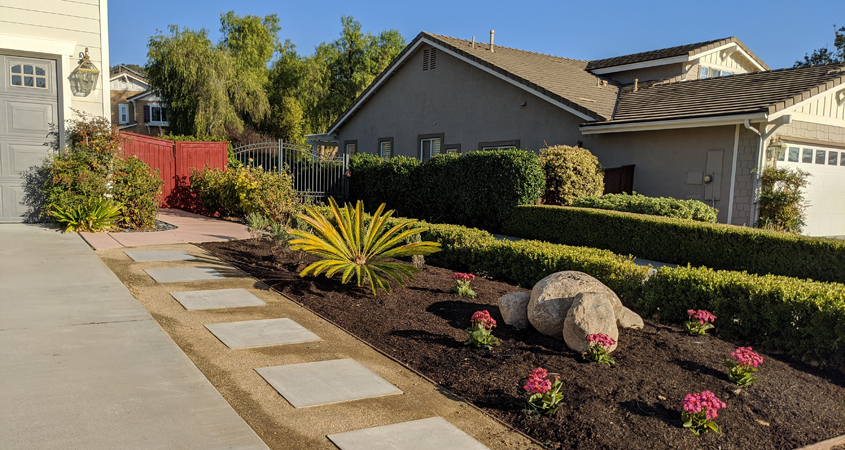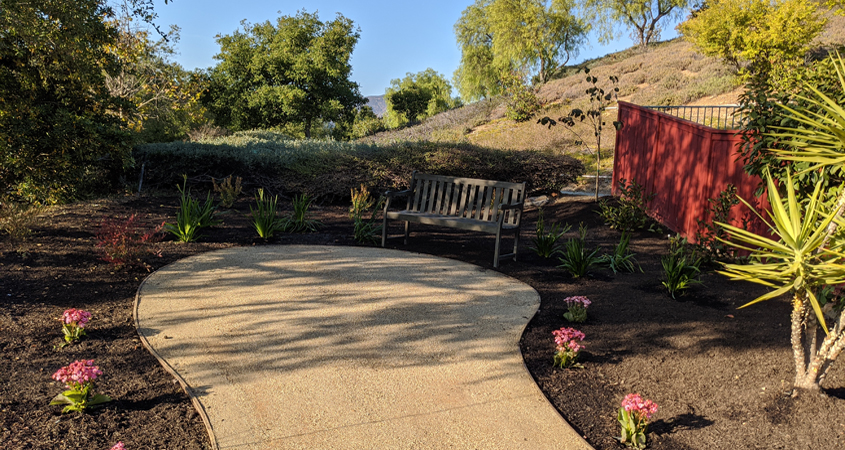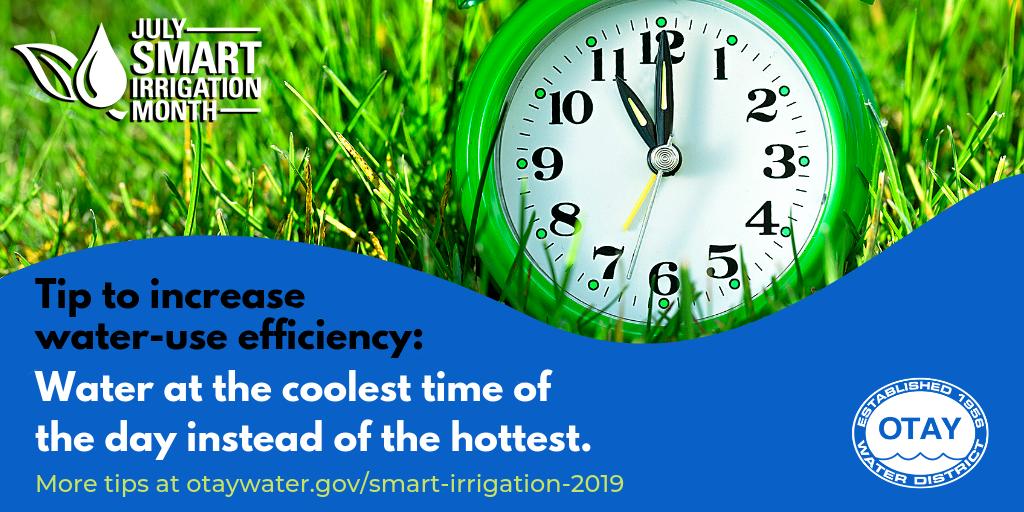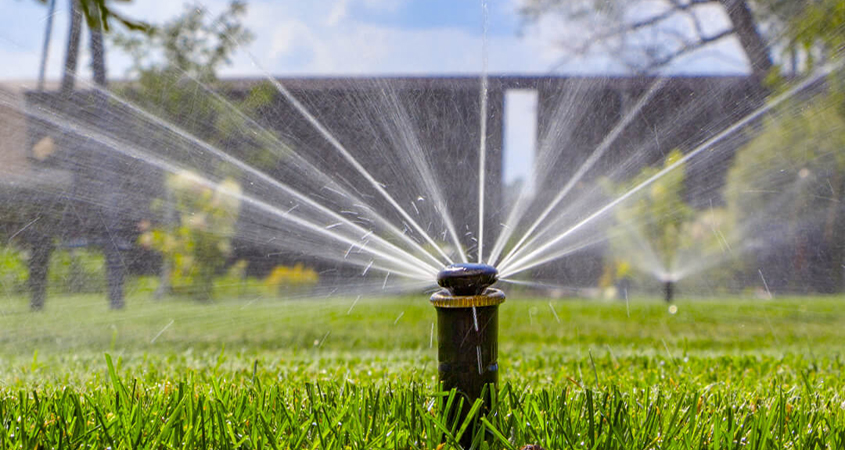Changes in Snowmelt Threaten Farmers in Western U.S.
Farmers in parts of the western United States who rely on snowmelt to help irrigate their crops will be among the hardest hit in the world by climate change, a new study reveals.
Farmers in parts of the western United States who rely on snowmelt to help irrigate their crops will be among the hardest hit in the world by climate change, a new study reveals.
The Santa Fe Irrigation District is seeking a new local representation after Division 1 Director Kenneth Dunford submitted his resignation. Dunford sent notice to the district and his fellow board members that he had made a commitment to move to Carlsbad; his last day of service was March 31.
The vacancy will be filled by the appointment process and the new board director will serve until the November 2020 election.
Vallecitos Water District Development Services Coordinator Eileen Koonce transformed the front yard at her new home into a beautiful water-efficient design with help from the San Diego County Water Authority’s Landscape Makeover Program.
As a new homeowner, when Koonce received her first water bill, she decided to figure out a way to reduce her water bill and her water usage. She realized the thirsty lawn covering the front yard had to go.
“As an employee of the District, we are always talking to customers about how they can reduce water use in their landscape, and what better time to put that theme to use than in my own yard,” said Koonce.
The Vallecitos Water District was hosting the Water Authority’s WaterSmart Landscape Makeover Program at the time. After Koonce saw the great turnout, she decided she wanted to participate in the program.

Homeowner Eileen Koonce discovered watersmart landscaping can be colorful and attractive. Photo: Vallecitos Water District
Koonce said she enjoyed working with the instructors.
“They bring the language down to the do-it-yourselfers,” she said. “They walk you through every part of it and if you have questions, they can help you out. You feel empowered because you can understand the process.”
Koonce tackled most of the design work herself with the help of instructors, who are licensed landscape architects. They also helped Koonce pick out the plants and choose an irrigation system.
She also applied for a turf rebate through the Metropolitan Water District’s Turf Rebate Program. Koonce said the application process was easy for her to follow, and she met all the criteria for acceptance into the program.
Koonce wanted a garden that would attract butterflies and birds, especially hummingbirds. She says her top takeaway from the WaterSmart course is how many attractive landscape options exist. Many beautiful, flowering plants do not require a lot of water.
“The WaterSmart Landscape Makeover Series is a great way to gather the skills needed to make your front yard transformation happen,” said Michelle Landis, course instructor and Registered Landscape Architect. “The WaterSmart Landscape Makeover Series also teaches the skills needed to tap into the new, local turf removal rebates. We invite you to join us for one of the sessions above to transform your front yard into money-saving, WaterSmart design.”
Koonce said she realizes a $70 per month savings on her water bill since her landscape makeover. And no longer spends time mowing a lawn.

Eileen Koonce says she was able to install her own landscaping with the help she received from instructors. Photo: Vallecitos Water District
The WaterSmart education program offers free three-hour workshops and a four-class landscaping makeover series. Three-hour workshops are scheduled on weeknights and Saturdays from March through October.
The four-class series is currently enrolling participants for March in Encinitas and in El Cajon. The series is also open in Oceanside and San Diego in April. Find participation requirements and register for the free series online at WaterSmartSD.org.
The Interior Department on Friday awarded the nation’s largest farm water district a permanent entitlement to annual irrigation deliveries that amount to roughly twice as much water as the nearly 4 million residents of Los Angeles use in a year.
Gaining a permanent contract for so much cheap Central Valley Project water represents a major milestone for Westlands Water District, which supplies some of the state’s wealthiest growers and has long-standing ties to Interior Secretary David Bernhardt.
Gov. Gavin Newsom, in a preemptive strike against President Donald Trump, said Wednesday he plans to sue Trump’s administration to block a controversial plan to increase water deliveries to the San Joaquin Valley.
Newsom’s office said he “will file legal action in the coming days … to protect highly imperiled fish species close to extinction.”
The announcement came just minutes before Trump appeared in Bakersfield to announce he’s finalized an order removing regulatory roadblocks and enabling the giant Sacramento-San Joaquin Delta pumps to deliver additional water to the southern half of the state.
Encinitas, Calif. — Olivenhain Municipal Water District connected Village Park Townhomes 2 Homeowners Association to its recycled water system this week. Using recycled water to meet irrigation needs will lower the HOA’s water bills and save an estimated seven million gallons of potable water each year.
“We are happy to see another HOA make the decision to invest in recycled water for irrigation,” said OMWD Board President Ed Sprague. “Converting to locally produced recycled water is a sustainable choice for customers like HOAs, municipalities, golf courses, and schools.”
San Diego regional water agencies are sharing water-efficiency tips during “Smart Irrigation Month.”
July is traditionally the month of peak demand for outdoor water use and the reason it was chosen as Smart Irrigation Month when it started in 2005. The month celebrates the social, economic, and environmental benefits of efficient irrigation for landscapes, recreation and agriculture.
San Diego regional water agencies are sharing water-efficiency tips during “Smart Irrigation Month.”
July is traditionally the month of peak demand for outdoor water use and the reason it was chosen as Smart Irrigation Month when it started in 2005. The month celebrates the social, economic, and environmental benefits of efficient irrigation for landscapes, recreation and agriculture.
Smart Irrigation Month highlights irrigation technology innovations and encourages water-efficient irrigation techniques to preserve the world’s fresh water supply.

The Otay Water District is among those participating in “Smart Irrigation Month” education via its social media channels and website. Photo: Otay Water District
The Otay Water District is helping its customers increase water-use efficiency during Smart Irrigation Month with a dedicated webpage of tips. Customers can apply for a free WaterSmart Checkup by calling 760-728-1332 or at watersmartcheckup.org
The Helix Water District also offers free home water use checkups to its customers by phone 619-667-6626 or email
And, the City of Oceanside Water Utilities Department is hosting a free Smart Irrigation Workshop at Mira Costa College on Saturday, July 13. The event has reached capacity, but customers can all 760-435-5816 to get on a waiting list and be notified about future events.

Inspect your sprinkler heads regularly to make sure they are not obstructed or watering onto pavement or other hardscapes. Photo: Irrigation Association
July is an ideal month to perform a check on current irrigation systems and determine whether any practices can be improved to save water. The San Diego County Water Authority offers these nine Smart Irrigation Month tips:
Find more tips and information on Smart Irrigation Month at WaterSmartSD.org
As the focus on infrastructure retakes center stage in Washington, we hope lawmakers don’t overlook a prime opportunity to invest in Western water and irrigation systems. Here in the West, our dams, irrigation systems, canals and other infrastructure much of it more than a century old are past due for modernization. This is low-hanging fruit for infrastructure repair and it’s a bipartisan political winner, too. The 2018 Farm Bill recognized this opportunity to help prepare producers and watersheds for drought in the West.
Spray irrigation emits water in an overlapping pattern, while drip irrigation delivers water directly to the roots of plants. How do you decide which meets the needs of your landscaping?
Spray irrigation can be an efficient way to irrigate large landscapes with groundcover or uniform plant materials like lawns or meadows.
Spray systems apply water in gallons per minute (GPM), so if you know the application rate of each spray head, the distance between the heads, and the pressure of your system, it is relatively easy to figure out how much water is applied every time you run your irrigation.
Low volume spray heads apply water at about one-third the rate of conventional spray heads. Newer spray irrigation heads have improved spray with heavier droplets more resistant to wind. Landscaping with grade changes using spray heads should have check valves installed to prevent water flowing out of the lower point heads.
Challenges of spray irrigation include narrow areas surrounded by hardscape, or irregular patterns. Irregular patterns are particularly challenging, because spray irrigation requires head-to-head coverage to be efficient. Odd-shaped areas may be under or over watered. High-volume spray heads that emit water at a much higher rate than soil can absorb should be replaced.
Drip systems apply water in gallons per hour (GPH), so they often need to run for longer periods of time than spray systems. But the actual run time must always account for precipitation rate and runoff.
Installing subsurface systems (under at least two inches of mulch) is the most efficient way to irrigate nearly every type of garden area. Since the tubing is flexible, it can accommodate a variety of irregular shaped areas or rectangular areas when laid in a grid pattern, and in rings you can easily expand as trees or shrubs grow.
Challenges of drip irrigation include application of water too quickly for your soil to absorb. This needs to be considered when dripline grids are installed. Drip irrigation operates the most efficiently at low pressure (between 15 and 30 PSI). To achieve optimal performance, pressure regulation either at the valve or at the point of connection of the dripline to the buried lateral lines must be used. It is also essential to install some type of filtering system to keep the emitters from getting clogged.